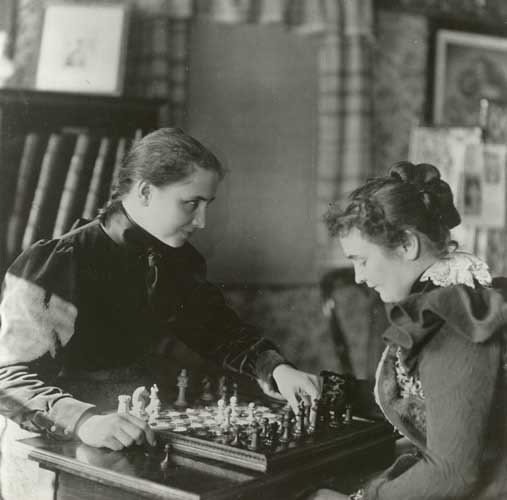|

Helen Adams Keller (l) playing chess with Anne Mansfield Sullivan (r) , 1900.
this information was provided to me by Lawrence Totaro of
Ultimate Chess Collecting
Mr. Totaro assembled a list of chess references in connection with Helen
Keller.
The Story of My Life by Helen Keller Doubleday, N.Y. 1903.
This book was originally a series of articles for the
Ladies Home Journal in 1902.
When a rainy day keeps me indoors, I amuse myself after the
manner of other girls. I like to knit and crochet; I read in the
happy-go-lucky way I love, here and there a line; or perhaps I play a game or
two of checkers or chess with a friend. I have a special board on which I play
these games. The squares are cut out, so that the men stand in them firmly.
The black checkers are flat and the white ones curved on top. Each checker has
a hole in the middle in which a brass knob can be placed to distinguish the
king from the commons. The chessmen are of two sizes, the white larger than
the black, so that I have no trouble in following my opponent's manoeuvers by
moving my hands lightly over the board after a play. The jar made by shifting
the men from one hole to another tells me when it is my turn.
Helen and Teacher: The Story of Helen
Keller and Anne Sullivan Macy by Joseph P. Lash
Addison Wesley, Ma. 1980.
p.663
The Pfeiffers invited her to dinner: "I think you know that I
have a collection of chess sets. With your wonderful gift to see and
understand intuitively, I believe you would enjoy being in our chess room. One
of the chess sets is said to have been made before Columbus discovered
America."
Her thank-you letter afterward was a paean to his chess collection. It ended
with the suggestion that a book should be written about it. "Why do you not
write it yourself, Mr. Pfeiffer? You would certainly not have a more
interested reader than myself if you did." She had an imagination that was
easily stirred and the rare gift of wanting to convey to those around her how
she had been moved.
p.261
She played chess and checkers with unusual concentration, and
was an enthusiastic "wheelwoman" often seen on the Cambridge streets on her
tandem
| 
